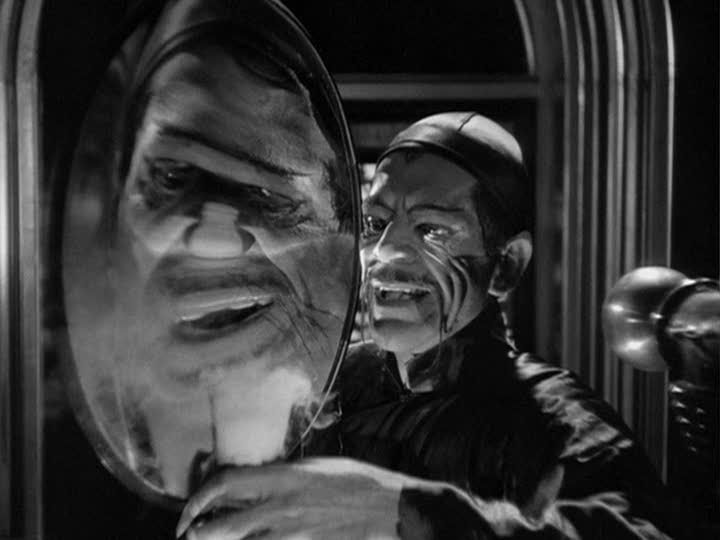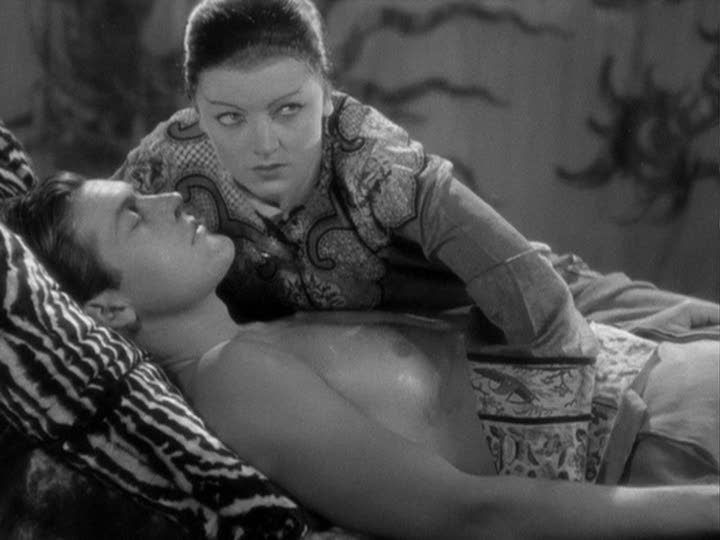
[This is a contribution to the Boris Karloff Blogathon, which has taken place from November 23-29 at the Frankensteinia blog.]
The Mask of Fu Manchu is, it has to be said, an utterly bizarre movie in so many ways. This quickie shocker casts Boris Karloff as the titular Fu Manchu, a sinister Chinese scientist and criminal who's determined to find the sword and mask of Genghis Khan in order to secure his own power as a new world conquerer. In order to do so, he kidnaps the professor Lionel Barton (Lawrence Grant), who's about to lead an expedition to the newly discovered tomb of Khan. When this doesn't work, Fu Manchu sends out inept assassins, kidnaps more scientists and adventurers, concocts elaborate torture devices involving pits of crocodiles and spiked walls, and plots in his laboratory with his slinky, oversexed daughter Fah Lo See (Myrna Loy). The plot is so over-the-top it's not worth taking seriously, so it's fortunate that the film, directed by Charles Brabin (replacing Charles Vidor, who was fired after a few days), offers up plenty of outrageous images and outlandish moments to distract from its ludicrous narrative.
The film's whole construction is rough and even sloppy. Everything seems to be happening at an accelerated pace, as though the actors were instructed to get through every scene as quickly as possible. This is often frankly hilarious, as the actors spit out lines, sometimes stumbling and stuttering — mistakes that obviously no one thought were worth doing another take to correct — or scrambling to perform some physical task at triple speed. The film was made early in the talkie era, and this too shows in the roughshod aesthetic. Brabin films mostly in static tableaux from a distance, occasionally tracking into or out of the scene but mostly just setting up and letting the action play out in front of the camera.
What happens in front of Brabin's camera, mostly, is Karloff and Loy outrageously mugging as the sinister Chinese villains, while the ineffectual heroes — led by Barton's daughter Sheila (Karen Morley, shamelessly overacting even in comparison to the makeup-caked Karloff and Loy) and her whitebread boyfriend Terry (Charles Starrett) — stumble into their enemies' traps over and over again. Karloff, even covered in ridiculous slant-eyed makeup, is in fine form, making his Fu Manchu snakelike and strangely dignified, insisting on being called "doctor" and stressing his fancy American/British education even as he vows to destroy white culture. Loy, as his daughter, is equally entertaining to watch; Fah Lo See is a seductress who turns her attentions to Terry almost as soon as she sees him. Fu Manchu is very aware of his daughter's ways, too, first offering her as a payment to Barton (with the girl standing right there) and then telling her to hold off on her usual seduction routine until her latest target has outlasted his usefulness to Fu Manchu's plans. Indeed, the film is surprisingly open and explicit in its sexual and other undertones. At one point, trying to find Fu Manchu, the adventurer Nayland Smith (Lewis Stone) asks an innkeeper for some "rest," and the obvious implication is that he wants either opium or women.

As interesting as these surface elements are, the film's strange undercurrents of homoerotic imagery and exoticization are even more fascinating. Once Terry is taken prisoner by Fu Manchu and Fah Lo See, he's stripped to the waist and chained to a slab so that Fah Lo See can lounge over him, running her long claw-like fingernails across his chest. And then there's the scene where Fu Manchu does the same thing, running his own nails across Terry's chest, mirroring his daughter's admiration of this white man. At one point, she even implicitly offers up Terry for her father's appreciation: "He is not entirely unhandsome, is he, my father?" To which Fu Manchu responds, "For a white man, no." This homoerotic undercurrent certainly extends to the black servants who are kept by the Chinese: strapping, muscular dark men, half-naked in tiny underwear-like shorts. They stand around looking like statues with their sculpted bodies, and it's hard to look at them without thinking that Fah Lo See, and probably Fu Manchu as well, likes having such models of masculine physicality hanging around.
Of course, beyond these under-the-surface sexual implications, there's the obvious fact that the film posits a fantasy world where Chinese warlords have black slaves: it's an expression of white fears about non-white races joining up to overthrow the whites. The film is shockingly racist, and not just the run-of-the-mill racism one expects of a 1930s film with stock Chinese villains. It's not just that the Chinese speak with affected accents or that the two most prominent Asian characters are played by white actors in slant-eye makeup. No, Fu Manchu's sinister plot is explicitly framed as a racial conquest, as an attempt by the sneaky, evil "yellow" people to conquer the white races. And not just conquer them, either. Fu Manchu extols his Chinese warriors into battle by promising that they will be able to kill all the white men and steal their women. Fu Manchu's goal is thus couched in terms of non-white races defiling white female sexuality, a tradition that stretches back at least to Birth of a Nation and is often at the core of racist thinking. Racist ideologies excite fear by suggesting that white female sexuality — represented here by willowy blonde Karen Morley, who looks frail and vulnerable despite her shallow tough attitude — is in danger of being corrupted and destroyed. The Mask of Fu Manchu goes even further by placing male sexuality in danger too, as Terry nearly gives in to the wiles of Fah Lo See. Of course, in one of the film's more laughable scenes — and there's some tight competition for that title — Sheila wins Terry back to white women by melodramatically urging him to put his arms around her and then smugly gloating at Fah Lo See when he wakes out of his trance.
Because of all this drama surrounding race and sexuality, The Mask of Fu Manchu is a fascinating and problematic film, messy and absurd and teeming with wild images. Fu Manchu's introduction is especially iconic, as the mad doctor appears, sneering and mugging, on the right side of the frame while on the left an oval funhouse mirror distorts and stretches his face into a disembodied monstrous mask. Later, when Terry is being whipped by some of the black slaves under Fah Lo See's direction, Fu Manchu's head appears floating in blackness, disembodied again, leering at the spectacle of the white man's torture. Images like this, along with the ornate designs of things like Genghis Khan's forbidding tomb, make the film an interesting spectacle, dominated by lurid imagery, loony ideas and unfettered performances.
When we speak of pure camp, this is one that hits the bulls-eye. Myrana Loy's masochistic nymphomaniac is a hoot, Cedric Gibbons's set design is one of the most imaginative in this genre, and there's quite a delicious array of torture devices.
ReplyDeleteIt would be interesting to know if the film would have taken a tamer route under the more sedate Vidor (who was by any barometer of measurement a very fine director with several classics to his credit) but as you note the pre-code film yielded some racy situations.
Karloff delivers one of his best early performances here.
For the sake of the Karloff blogothon, I would say his greatest performance ever is as Cabman Grey in Val Lewton's THE BODY SNATCHER. In fact it was the best performance by any actor that year (1945).
Again, you penned a simply stupendous review here. Outstanding.
Thanks, Sam. Karloff does about as well as he can in this movie; it doesn't call for a great performance, but he delivers a suitably creepy and haughty one. He was at his best, obviously, in the films he made with Val Lewton as well as his great turn in Edgar Ulmer's The Black Cat.
ReplyDeleteTerrific review. I've been fascinated by this film since seeing it for the first time 3 and a half years ago, and not so long ago I couldn't resist watching it again while in the midst of a Tod Browning immersion that involved borrowing the Mark of the Vampire DVD (to which Mask of Fu Manchu is co-feature) from the library.
ReplyDeleteThe stereotypes are unforgivable, of course, for today or for any day. But they're also so ludicrous that I can't help but cheer on Fu and Fah, hoping they'll triumph in their plans to dominate the inferior white race (the performances of the nominal European "heroes" of the picture are bad enough that it's hard to be very sympathetic to their characters).
Charles Brabin is clearly an under-appreciated figure. He made few talkies and even fewer silent films that are still remembered today, but in the silent era he was an important director, married to Theda Bara, and responsible for at least one near-masterpiece of the action genre: the 1927 Valley of the Giants starring the equally-forgotten Milton Sills.
No less a critic than Jonathan Rosenbaum lists the Mask of Fu Manchu among his 1000 essential films, though I've not seen him write about the film anywhere else (not that I've made a point to track down all his writings).
Thanks for the interesting comments, Brian, especially the remarks about Brabin, about whom I knew nothing prior to seeing this film. Based on your comments and the somewhat stiff aesthetic on display here, it sounds like he was one of those directors better suited to silent style than the style of the early talkie era.
ReplyDeleteAnd yes, this is one of those films where one can't help but root for the villains, just because the heroes are so bland and badly acted. It seems like this was pretty common in a lot of old Hollywood fare; the villains are so much more fun than the people we're "supposed" to be rooting for.
I'd certainly be interested to read Rosenbaum defending that choice. It's an interesting film in many ways, but "essential?" I dunno.
I do wonder if this film provided some of the inspiration for Milton Caniff's great comic strip Terry and the Pirates. Myrna Loy certainly seems like a prototypical Dragon Lady here, and the hero is even named Terry, though Caniff's version of the white hero is certainly more convincing and nuanced.